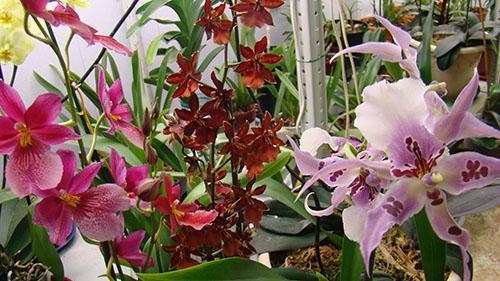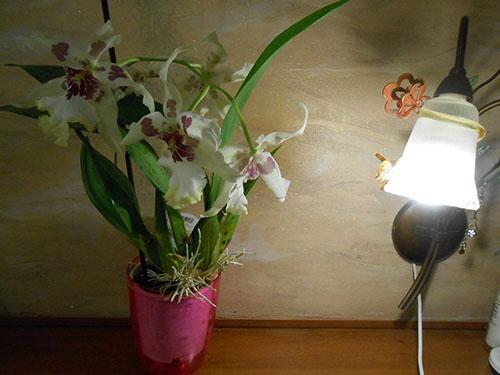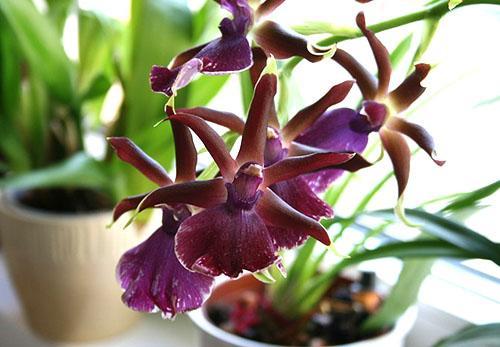Unpretentious Cumbria orchid hybrid
 Few people can not express their admiration when they see how the Cambria orchid blooms. The unusual color and shape of the petals was obtained by crossing Oncidium varieties, Miltonia, Brassia. There are a lot of varieties of Cumbria, they can only be distinguished by the star-shaped flowers and the presence of pseudobulbs. Hybrid origin provides plant resistance to diseases and unpretentiousness orchid care.
Few people can not express their admiration when they see how the Cambria orchid blooms. The unusual color and shape of the petals was obtained by crossing Oncidium varieties, Miltonia, Brassia. There are a lot of varieties of Cumbria, they can only be distinguished by the star-shaped flowers and the presence of pseudobulbs. Hybrid origin provides plant resistance to diseases and unpretentiousness orchid care.
Description of the species

You need to purchase a plant with 3 or more pseudobulbs, such flowers will grow and bloom well. If the cambrian orchid has only 1 bulb, then it will die after flowering.
The diameter of the flowers is 2-10 cm, the most common are red varieties with white or yellowish spots. However, there are also varieties with yellow, purple, burgundy petals.
Plant Growing Basics
 The rules for caring for the Cumbria orchid at home are simple, but you need to know them in order to create a favorable environment for the development and flowering of the plant.
The rules for caring for the Cumbria orchid at home are simple, but you need to know them in order to create a favorable environment for the development and flowering of the plant.
The roots of the Cumbria orchid are thin and easily damaged. They can be located both inside the pot and above the surface of the substrate. The upward growth of the plant stimulates the formation of new pseudobulbs. Until the old pseudobulbs die off, the flower is not transplanted.
Choosing a pot location and light intensity
The plant is light-loving, but the sun's rays should be diffused. Direct exposure to the sun causes burns to thin and soft leaves. In summer, the plant is placed on the eastern, northeastern or western windowsill. If the windows face south, then it is necessary to create a slight darkening with mesh, tulle.
In winter, the flower can be at rest or in bloom. Sleeping plants do not require additional illumination, and blooming is recommended to create a daylight hours of at least 12 hours. The splendor of the orchid flowering will depend on the intensity of the lighting.
Temperature and humidity level
 Cumbria is a flower that is insensitive to indoor temperatures. The most favorable temperature for it is 18-25 ̊С.
Cumbria is a flower that is insensitive to indoor temperatures. The most favorable temperature for it is 18-25 ̊С.
Unlike other orchids, this hybrid does not require fluctuations in day and night temperatures. The flower does not need to be taken out to the balcony or other cool room to activate flowering.
During the period of peduncle formation, it is better to provide the plant with increased air humidity in the room. To do this, you can put a container of water near the pot or spray the leaves with a fine spray. During flowering or dormancy, an increase in the humidity level is not required; 25-30% is considered a sufficient level.
Watering mode
 When caring for Cumbria orchids at home, proper watering of the plant is very important. Water can be used only soft, to soften it is passed through a filter, defended, boiled and cooled. If you water the flower from above, then moisture quickly seeps through the bark without wetting it.Therefore, the best way to wet the substrate is by submerged watering.
When caring for Cumbria orchids at home, proper watering of the plant is very important. Water can be used only soft, to soften it is passed through a filter, defended, boiled and cooled. If you water the flower from above, then moisture quickly seeps through the bark without wetting it.Therefore, the best way to wet the substrate is by submerged watering.
Warm soft water is poured into a small basin or wide bucket and the pot with the Cambria orchid is placed on the bottom. The water level should not be higher than the edge of the pot so that the pseudobulbs do not get wet. If water gets on them, rapid decay is possible.
Soak the pot in water for 5-20 minutes. Flowering plants require more watering orchids at rest it is recommended to moisturize only slightly. After the flower pot has been removed from the water, you need to let it stand at the bottom of the bath so that all excess moisture drains out. Otherwise, the delicate roots will rot. It is recommended to repeat the dives after the substrate is completely dry. In humid rooms this happens in 10-14 days, during the heating season in 5-7 days.
Choice of substrate and pot
The soil for Cumbria should be very light. The standard combination of peat, earth, sand is not used. The basis of the substrate is pine bark, to which chopped dry moss and coal are added. As a drainage, pieces of foam are placed on the bottom of the pot, it does not absorb water, and will provide dryness to the roots.
If the air in the room is too dry, then the substrate is enriched with perlite granules. It helps to retain moisture at the roots. Coconut, foam chips will help increase air permeability at the roots.
You can make the substrate yourself or purchase a ready-made mixture at a flower shop. A small pot is chosen so that the roots completely fill it inside, and there is still some free space. Unlike other orchids, the Cumbrian root system does not like sunlight, so a ceramic or plastic container is optimal. For larger plants, choose a stable, heavy pot.
Reproduction and transplantation of Cumbria
 The flower does not tolerate transplants, so they need to be done only if necessary:
The flower does not tolerate transplants, so they need to be done only if necessary:
- a large number of pseudobulbs are located above the surface of the pot,
- decay of part of the root system is observed,
- the soil is salted from frequent fertilization.
A new pot is chosen with a diameter of 1-2 cm larger than the previous one. The plant should be at rest, all peduncles, old yellowed pseudobulbs should be removed. The normal frequency of Cumbria transplantation is considered 1 time in 2-3 years.
During the transplanting process, it is possible to divide an adult plant into several separate flowers. To do this, pseudobulbs with roots are carefully separated, trying to damage them minimally. It is better if both old and young bulbs remain in each plant. The old will provide nutrition, the young will bloom.
 Fractured points should be sprinkled with crushed coal. The separated plants are fixed to a support stick and watering begins only after a week.
Fractured points should be sprinkled with crushed coal. The separated plants are fixed to a support stick and watering begins only after a week.
When and how to fertilize the plant
 Top dressing is an important process when caring for cambria at home, a photo of the best fertilizer is presented below.
Top dressing is an important process when caring for cambria at home, a photo of the best fertilizer is presented below.
Complex mineral fertilizers are used for nutrition. When purchasing a new product, you need to gradually increase the dose so that the plant gets used to it.
It is necessary to apply fertilizer to the substrate during the period of growth and flowering: from February to October. The tool is added to the water when bathing or the leaves are sprayed with a solution through a fine spray bottle. It is not necessary to apply an excessive amount of fertilizer, the flower will not grow or bloom better.
Bloom
 Peduncles appear from formed pseudobulbs at any time of the year. If the arrow appears in winter, then it is recommended to highlight the plant so that the small buds do not fall off. Cambria, the photo of which is presented below, has one peduncle.
Peduncles appear from formed pseudobulbs at any time of the year. If the arrow appears in winter, then it is recommended to highlight the plant so that the small buds do not fall off. Cambria, the photo of which is presented below, has one peduncle.
If the orchid does not bloom for more than 12 months, then this signals excessive watering and feeding.
When a new pseudobulb appears, it is necessary to reduce the frequency of watering, as a result, it will shrink. Reduction of watering is carried out for 2-4 weeks, after which the plant should have a peduncle.Once this occurs, normal watering mode returns.
Possible diseases and pests
 Like all indoor plants, the orchid can become infected with fungal or bacterial infections. In the presence of fungi, small specks appear on the surface of the sheets, but this is not reflected in growth or flowering. The diseased plant is treated with a fungicide solution.
Like all indoor plants, the orchid can become infected with fungal or bacterial infections. In the presence of fungi, small specks appear on the surface of the sheets, but this is not reflected in growth or flowering. The diseased plant is treated with a fungicide solution.
 Other possible growing problems are:
Other possible growing problems are:
- Dark spots on the leaves. The reason is a waterlogged substrate. It is necessary to reduce the amount of watering.
- The pseudobulbs shriveled and the leaves turned yellow. The reason is the appearance of snails in a pot. An urgent transplant with a replacement substrate is required.
- The appearance of yellow areas on the leaves. They are caused by too much direct sunlight. It is recommended to rearrange or darken the pot.
Also, spider mites, whiteflies, orchid aphids, scale insects, thrips are dangerous for the plant. To remove them, use special ready-made preparations.
You can easily grow a flower if you follow all the recommendations for home care, a photo of a home Cumbria is presented below.
Orchid species Cumbria
There are many varieties of this hybrid orchid species. We will present the most beautiful in the photo.
Cambria phalaenopsis
Beallara Margarita Holm
Catatanta Pacific Sun Spots
Colmanara Tropic Jungle
Odontoglossum Stirbik
Odontoglossum Khansueli Isler
Odontoglossum Cambria Elegant
The instructional video shows the basics of caring for cambria at home. (see others types of orchids)